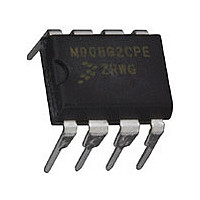MC68HC908QT2CPE Freescale, MC68HC908QT2CPE Datasheet - Page 126

MC68HC908QT2CPE
Manufacturer Part Number
MC68HC908QT2CPE
Description
Manufacturer
Freescale
Datasheet
1.MC68HC908QT2CPE.pdf
(184 pages)
Specifications of MC68HC908QT2CPE
Cpu Family
HC08
Device Core Size
8b
Frequency (max)
8MHz
Total Internal Ram Size
128Byte
# I/os (max)
6
Number Of Timers - General Purpose
2
Operating Supply Voltage (typ)
3.3/5V
Operating Supply Voltage (max)
5.5V
Operating Supply Voltage (min)
2.7V
On-chip Adc
4-chx8-bit
Instruction Set Architecture
CISC
Operating Temp Range
-40C to 85C
Operating Temperature Classification
Industrial
Mounting
Through Hole
Pin Count
8
Package Type
PDIP
Program Memory Type
Flash
Program Memory Size
1.5KB
Lead Free Status / RoHS Status
Compliant
- Current page: 126 of 184
- Download datasheet (2Mb)
Timer Interface Module (TIM)
14.6 Wait Mode
The WAIT instruction puts the MCU in low power-consumption standby mode.
The TIM remains active after the execution of a WAIT instruction. In wait mode the TIM registers are not
accessible by the CPU. Any enabled CPU interrupt request from the TIM can bring the MCU out of wait
mode.
If TIM functions are not required during wait mode, reduce power consumption by stopping the TIM before
executing the WAIT instruction.
14.7 TIM During Break Interrupts
A break interrupt stops the TIM counter.
The system integration module (SIM) controls whether status bits in other modules can be cleared during
the break state. The BCFE bit in the break flag control register (BFCR) enables software to clear status
bits during the break state. See
To allow software to clear status bits during a break interrupt, write a 1 to the BCFE bit. If a status bit is
cleared during the break state, it remains cleared when the MCU exits the break state.
To protect status bits during the break state, write a 0 to the BCFE bit. With BCFE at 0 (its default state),
software can read and write I/O registers during the break state without affecting status bits. Some status
bits have a two-step read/write clearing procedure. If software does the first step on such a bit before the
break, the bit cannot change during the break state as long as BCFE is at 0. After the break, doing the
second step clears the status bit.
14.8 Input/Output Signals
Port A shares three of its pins with the TIM. Two TIM channel I/O pins are PTA0/TCH0 and PTA1/TCH1
and an alternate clock source is PTA2/TCLK.
14.8.1 TIM Clock Pin (PTA2/TCLK)
PTA2/TCLK
prescaled internal bus clock. Select the PTA2/TCLK input by writing 1s to the three prescaler select bits,
PS[2–0]. (See
it is an input regardless of port pin initialization.
14.8.2 TIM Channel I/O Pins (PTA0/TCH0 and PTA1/TCH1)
Each channel I/O pin is programmable independently as an input capture pin or an output compare pin.
PTA0/TCH0 can be configured as a buffered output compare or buffered PWM pin.
14.9 Input/Output Registers
The following I/O registers control and monitor operation of the TIM:
126
•
•
•
•
•
TIM status and control register (TSC)
TIM counter registers (TCNTH:TCNTL)
TIM counter modulo registers (TMODH:TMODL)
TIM channel status and control registers (TSC0 and TSC1)
TIM channel registers (TCH0H:TCH0L and TCH1H:TCH1L)
is an external clock input that can be the clock source for the TIM counter instead of the
14.9.1 TIM Status and Control
13.8.2 Break Flag Control Register.
MC68HC908QY/QT Family Data Sheet, Rev. 6
Register.) When the PTA2/TCLK pin is the TIM clock input,
Freescale Semiconductor
Related parts for MC68HC908QT2CPE
Image
Part Number
Description
Manufacturer
Datasheet
Request
R

Part Number:
Description:
TOWER ELEVATOR BOARDS HARDWARE
Manufacturer:
Freescale Semiconductor
Datasheet:

Part Number:
Description:
TOWER SERIAL I/O HARDWARE
Manufacturer:
Freescale Semiconductor
Datasheet:

Part Number:
Description:
LCD MODULE FOR TWR SYSTEM
Manufacturer:
Freescale Semiconductor
Datasheet:

Part Number:
Description:
DAUGHTER LCD WVGA I.MX51
Manufacturer:
Freescale Semiconductor
Datasheet:

Part Number:
Description:
TOWER SYSTEM BOARD MPC5125
Manufacturer:
Freescale Semiconductor
Datasheet:

Part Number:
Description:
KIT EVALUATION I.MX51
Manufacturer:
Freescale Semiconductor
Datasheet:

Part Number:
Description:
KIT DEVELOPMENT WINCE IMX25
Manufacturer:
Freescale Semiconductor
Datasheet:

Part Number:
Description:
TOWER SYSTEM KIT MPC5125
Manufacturer:
Freescale Semiconductor
Datasheet:

Part Number:
Description:
TOWER SYSTEM BOARD K40X256
Manufacturer:
Freescale Semiconductor
Datasheet:

Part Number:
Description:
TOWER SYSTEM KIT K40X256
Manufacturer:
Freescale Semiconductor
Datasheet:

Part Number:
Description:
Microcontrollers (MCU) MX28 PLATFORM DEV KIT
Manufacturer:
Freescale Semiconductor
Datasheet:

Part Number:
Description:
MCU, MPU & DSP Development Tools IAR KickStart Kit for Kinetis K60
Manufacturer:
Freescale Semiconductor
Datasheet:

Part Number:
Description:
24BIT HDMI MX535/08
Manufacturer:
Freescale Semiconductor
Datasheet:
Part Number:
Description:
Manufacturer:
Freescale Semiconductor, Inc
Datasheet:
Part Number:
Description:
Manufacturer:
Freescale Semiconductor, Inc
Datasheet:










